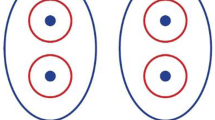Abstract
The networking of theories is an increasingly common and powerful approach to analyzing complex phenomena such as learning processes in classrooms. In this paper, we aim to advance the theoretical coordination of two approaches that we have previously combined to analyze individual, small group, and whole class mathematical progress. The theoretical advances we make are twofold. First, we identify and illuminate environmental and internal-theoretical commonalities across the two approaches, commonalities that contribute to the productivity of networking. Second, we propose an argumentative grammar for the networking, thus elevating the methodological logic and rationale of networking in this case and potentially in general.



Similar content being viewed by others
References
Artigue, M., & Blomhøj, M. (2013). Conceptualizing inquiry-based education in mathematics. ZDM Mathematics Education, 45(6), 797–810.
Artigue, M., & Bosch, M. (2014). Reflection on networking through the praxeological lens. In A. Bikner-Ahsbahs & S. Prediger (Eds.), Networking of theories as a research practice in mathematics education (pp. 249–265). Dordrecht, The Netherlands: Springer.
Bakker, A. (2016). Book review: Networking theories as an example of boundary crossing. Angelika Bikner-Ahsbahs and Susanne Prediger (Eds.) (2014) Networking of theories as a research practice in mathematics education. Educational Studies in Mathematics, 93, 265–273.
Bakker, A. (2017). Towards argumentative grammars of design research. In T. Dooley & G. Gueudet (Eds.). Proceedings of the Tenth Congress of the European Society for Research in Mathematics Education (CERME10, pp. 2730–2737). Dublin, Ireland: DCU Institute of Education and ERME.
Bikner-Ahsbahs, A., Bakker, A., Haspekian, M., & Maracci, M. (2017). Introduction to the Thematic Working Group 17 on theoretical perspectives in mathematics education research. In T. Dooley & G. Gueudet (Eds.), Proceedings of the Tenth Congress of the European Society for Research in Mathematics Education (CERME10, pp. 2683–2690). Dublin, Ireland: DCU Institute of Education and ERME.
Bikner-Ahsbahs, A., & Prediger, S. (2014). Networking as research practices: Methodological lessons learnt from the case studies. In A. Bikner & S. Prediger (Eds.), Networking of theories as a research practice in mathematics education (pp. 235–247). Dordrecht, The Netherlands: Springer.
Cobb, P., Jackson, K., & Dunlap, C. (2016). Design research: An analysis and critique. In L. D. English & D. Kirshner (Eds.), Handbook of international research in mathematics education (3rd ed.pp. 418–503). New York, USA: Routledge.
Cobb, P., & Yackel, E. (1996). Constructivist, emergent, and sociocultural perspectives in the context of developmental research. Educational Psychologist, 31, 175–190.
diSessa, A., & Cobb, P. (2004). Ontological innovation and the role of theory in design experiments. Journal of the Learning Sciences, 13(1), 77–103.
Dreyfus, T., & Tsamir, P. (2004). Ben’s consolidation of knowledge structures about infinite sets. Journal of Mathematical Behavior, 23(3), 271–300.
Gravemeijer, K. (1994). Developing realistic mathematics education. Utrecht, the Netherlands: Freudenthal Institute.
Hershkowitz, R., Hadas, N., Dreyfus, T., & Schwarz, B. (2007). Processes of abstraction, from individuals’ constructing of knowledge to a group’s “shared knowledge”. Mathematics Education Research Journal, 19(2), 41–68.
Hershkowitz, R., Schwarz, B., & Dreyfus, T. (2001). Abstraction in context: Epistemic actions. Journal for Research in Mathematics Education, 32, 195–222.
Hershkowitz, R., Tabach, M., Rasmussen, C., & Dreyfus, T. (2014). Knowledge shifts in a probability classroom: A case study of coordinating two methodologies. ZDM Mathematics Education, 46(3), 363–387.
Kelly, A. E. (2004). Design research in education: Yes, but is it methodological? Journal of the Learning Sciences, 13(1), 115–128.
Laursen, S., & Rasmussen, C. (2019). I on the prize: Inquiry approaches in undergraduate mathematics education. International Journal of Research in Undergraduate Mathematics Education, 5(1), 129–149.
Prediger, S., & Bikner-Ahsbahs, A. (2014). Introduction to networking: Networking strategies and their background. In A. Bikner & S. Prediger (Eds.), Networking of theories as a research practice in mathematics education (pp. 117–125). Dordrecht, The Netherlands: Springer.
Prediger, S., Bikner-Ahsbahs, A., & Arzarello, F. (2008). Networking strategies and methods for connecting theoretical approaches: First steps towards a conceptual framework. ZDM Mathematics Education, 40, 165–178.
Rasmussen, C., & Stephan, M. (2008). A methodology for documenting collective activity. In A. E. Kelly, R. A. Lesh, & J. Y. Baek (Eds.), Handbook of design research methods in education: Innovations in science, technology, engineering, and mathematics learning and teaching (pp. 195–215). New York: Routledge.
Stephan, M., & Rasmussen, C. (2002). Classroom mathematical practices in differential equations. Journal of Mathematical Behavior, 21, 459–490.
Tabach, M., Hershkowitz, R., Rasmussen, C., & Dreyfus, T. (2014). Knowledge shifts in the classroom—A case study. Journal of Mathematical Behavior, 33, 192–208.
Toulmin, S. (1969). The uses of argument. Cambridge, England: Cambridge University Press.
Treffers, A. (1987). Three dimensions. A model of goal and theory description in mathematics education: The Wiskobas project. Dordrecht: Kluwer Academic Publishers.
Author information
Authors and Affiliations
Corresponding author
Additional information
Publisher’s note
Springer Nature remains neutral with regard to jurisdictional claims in published maps and institutional affiliations.
Electronic supplementary material
ESM 1
(DOCX 22 kb)
Rights and permissions
About this article
Cite this article
Tabach, M., Rasmussen, C., Dreyfus, T. et al. Towards an argumentative grammar for networking: a case of coordinating two approaches. Educ Stud Math 103, 139–155 (2020). https://doi.org/10.1007/s10649-020-09934-7
Published:
Issue Date:
DOI: https://doi.org/10.1007/s10649-020-09934-7




